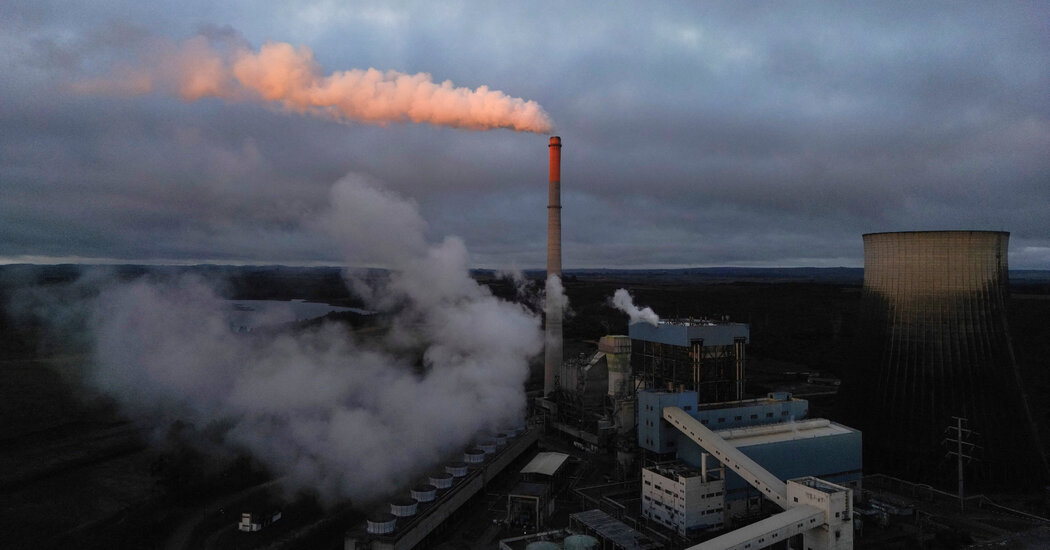
Global fossil fuel emissions are on track to soar to record highs in 2025 and show no signs of declining overall, although there are indications of a recent slowdown in China’s emissions, researchers said on Wednesday.
This year, nations are projected to emit roughly 38.1 billion tons of planet-warming carbon dioxide by burning oil, gas and coal for energy and by manufacturing cement, according to data from the Global Carbon Project. Those sources are the largest contributors to human-caused climate change. The total is roughly 1.1 percent more than the world emitted in 2024.
Not everywhere saw a large increase. Emissions appear to have stayed nearly flat in China and Europe, but rose significantly in the United States and much of the rest of the world.
The increase in emissions comes a decade after world leaders reached a landmark agreement in Paris that aimed to slow and then stop the planet from warming. Doing so would require global emissions to peak at some point and then fall to nearly zero. That task becomes harder every year that emissions go up.
“It is 10 years since the Paris Agreement was adopted, and despite progress on many fronts, fossil carbon dioxide emissions continue their relentless rise,” said Glen Peters, a senior researcher at the CICERO Center for International Climate Research in Oslo and one of the authors of the report.
Defenders of the Paris Agreement point out that emissions are now rising more slowly than they otherwise would have, as many countries shift to less polluting forms of energy. Technologies like solar panels, wind turbines and electric vehicles are proliferating rapidly, raising hopes that emissions might peak soon.
So far, however, that hasn’t happened.
A relatively small number of countries account for most of the world’s emissions, with China responsible for 32 percent, the United States at 13 percent, India at 8 percent and the European Union at 6 percent.
The new report did contain one surprising finding: China’s emissions seem to be flattening after decades of breakneck growth, although there is some uncertainty because of lags in collecting data.
During the 2000s and 2010s, Chinese emissions soared as the country built hundreds of coal plants to fuel its industrial expansion. More recently, though, China has been installing enormous amounts of wind and solar power, and roughly half of all new cars sold in the country are now electric.
While the country still gets most of its energy from coal and other fossil fuels, the report estimates that its emissions will only rise about 0.4 percent this year, and could even end up declining. (A separate analysis by Carbon Brief, a climate research site, found that China’s emissions have plateaued for the past 18 months even as electricity demand has surged.)
Still, some experts said it was too early to say that China’s emissions have peaked.
“There is no clear peak” yet, said Jan Ivar Korsbakken, a senior researcher at CICERO. “The outlook going forward is highly uncertain due to policy changes that reduce economic incentives for renewable power and expected growth in the use of coal to produce chemical feedstocks.”
President Xi Jinping of China said this year his country would cut carbon dioxide and other pollution by at least 7 percent by 2035. But he made no promises on how high emissions might climb over the next few years before the cuts start.
In the United States, emissions are expected to rise roughly 1.9 percent for this year, in part because last winter was relatively cold and homes used more energy for heating. Electric utilities also burned more coal, the most polluting of all fossil fuels, as the country looked to export more natural gas, a lower-carbon alternative.
U.S. carbon dioxide emissions passed their peak years ago and have been declining over time, although many analysts expect them to fall more slowly under the Trump administration, which has disavowed efforts to tackle global warming and has sought to promote greater use of coal, oil and natural gas.
In many countries, annual variability can have an even bigger effect on emissions than policies or technology. Emissions in Europe may have risen slightly this year, around 0.4 percent, in part because of a relatively cold February and a drop in power supplies from hydroelectric dams. Conversely, an early monsoon in India led to a relatively cool May and June, which meant the country needed to burn less coal than expected during those months.
In the rest of the world, emissions increased roughly 1.1 percent this year. International air travel increased especially rapidly and has rebounded to levels seen before the 2020 coronavirus pandemic.
The report did find small signs of progress on climate change. There were 35 countries that saw a consistent decrease in their emissions over the past decade, up from 21 countries in the decade before.
Yet at this month’s U.N. climate summit in Belém, most leaders have conceded that the action to date has not been sufficient.
“Yes, progress has been real,” Simon Stiell, the U.N. climate chief, said on Monday. “But it’s not nearly enough.”
Brad Plumer is a Times reporter who covers technology and policy efforts to address global warming.
The post Carbon Dioxide Emissions Head for Another Record in 2025 appeared first on New York Times.



